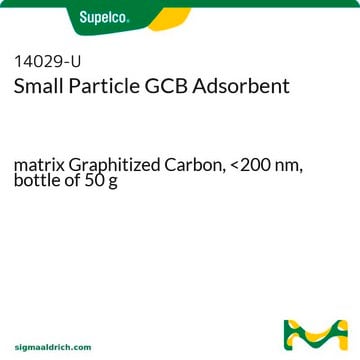699624
Carbon, mesoporous
nanopowder, graphitized, less than 250 ppm Al, Ti, Fe, Ni, Cu, and Zn combined
Synonym(s):
Graphite nanoparticles, Graphitized carbon, Graphitized carbon black
Select a Size
About This Item
Recommended Products
Quality Level
form
nanopowder
surface area
50-100 m2/g
pore size
0.25 cm3/g pore volume (typical)
137 Å average pore diameter (typical)
bp
4827 °C
mp
3654-3697 °C
density
1.828 g/cm3 (absolute, typical)
bulk density
0.075 g/cm3
SMILES string
[C]
InChI
1S/C
InChI key
OKTJSMMVPCPJKN-UHFFFAOYSA-N
Looking for similar products? Visit Product Comparison Guide
Related Categories
General description
Application
Storage Class Code
11 - Combustible Solids
WGK
nwg
Flash Point(F)
Not applicable
Flash Point(C)
Not applicable
Personal Protective Equipment
Regulatory Listings
Regulatory Listings are mainly provided for chemical products. Only limited information can be provided here for non-chemical products. No entry means none of the components are listed. It is the user’s obligation to ensure the safe and legal use of the product.
JAN Code
699624-VAR:
699624-5G:4548173923871
699624-BULK:
699624-25G:4548173923864
Choose from one of the most recent versions:
Already Own This Product?
Find documentation for the products that you have recently purchased in the Document Library.
Customers Also Viewed
morphology and loss of barrier function in human
bronchial epithelium at noncytotoxic doses
Articles
Mesoporous Materials include a range of high surface area porous silicates with applications in gas adsorption, drug delivery, diagnostics and catalysis.
Mesoporous materials self-assemble from sol-gel precursors and amphiphiles, forming versatile structures for various applications.
Recent demand for electric and hybrid vehicles, coupled with a reduction in prices, has caused lithium-ion batteries (LIBs) to become an increasingly popular form of rechargeable battery technology.
Solid oxide fuel cells and electrolyzers show potential for chemical-to-electrical energy conversion, despite early development stages.
Active Filters
Our team of scientists has experience in all areas of research including Life Science, Material Science, Chemical Synthesis, Chromatography, Analytical and many others.
Contact Technical Service





